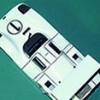I've been reading this thread with interest, and i have to admit that the 88 has always puzzled me, on many different levels.
I think i am right in saying that the original concept was designed with sliding skirts in mind, and then rejigged with vestigial fixed skirts before the car first ran, after the resolution of the 1980/81 fisa/foca wars..
As a fixed skirt machine the only way i could see it working was if the secondary - or was it primary - chassis , anyway, the sprung bodywork, was softly sprung and effectively just sat on the track by the time the car reached the end of the pitlane and stayed there.
In other words the opposite of what some press reports of the time were claiming as quotes from Lotus personnel - smoke and mirrors or the press getting the wrong end of the stick?
That being the case the aerodynamic centre of pressure - and hence aero balance - would have been pretty much fixed through the 'flight envelope' of the car, unless there was significant separation in the tunnels, which i am assuming there was not.
But the conventional car underneath would still have been transferring weight backwards and forwards as it braked and accelerated.
These days you design a tunnel car to have an aerodynamic centre of pressure that moves in sympathy with this transfer so that, for instance as you brake and throw weight forwards you also move the aero forwards .
One of the secrets to having a car that the drivers think is well balanced is how much of this you build in and at what point you limit the shift in aero.
Too much and the car will be 'on the nose', too little and it 'wont have any downforce'. What they mean is it wont have the downforce where they can make use of it.
But the 88 wouldn't have had any of that, so i'm not too sure how it would have felt to deAngelis and Mansell and others who drove it out on the limit. The car has been raced in Historics in recent years so maybe somebody from there can add some insight?
Anyway, it does make me wonder if the concept isn't actually fundamentally flawed - perhaps unless you add in active ride? We know that was coming, it was later painted as the 'answer' to the banning of the 88 concept, i wonder if it wasn't perhaps another part of the same package?
On a different note, the party line at the time was that the 87 was designed as a failsafe in case the 88 didnt work, whereas i have it on fairly good authority that the 87 came first (as you might expect from its type number) and that the 88 was then given the go ahead after the 86 test car was felt to be showing some promise.
A lot more to this story than meets the eye...
Peter




















